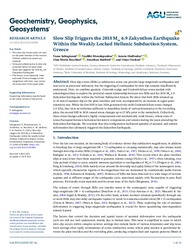Slow Slip Triggers the 2018 Mw 6.9 Zakynthos Earthquake Within the Weakly Locked Hellenic Subduction System, Greece
DOI: https://doi.org/10.1029/2021GC010090
Persistent URL: http://resolver.sub.uni-goettingen.de/purl?gldocs-11858/9779
Persistent URL: http://resolver.sub.uni-goettingen.de/purl?gldocs-11858/9779
Saltogianni, Vasso; Mouslopoulou, Vasiliki; Dielforder, Armin; Bocchini, Gian Maria; Bedford, Jonathan; Oncken, Onno, 2021: Slow Slip Triggers the 2018 Mw 6.9 Zakynthos Earthquake Within the Weakly Locked Hellenic Subduction System, Greece. In: Geochemistry, Geophysics, Geosystems, Band 22, 11, DOI: 10.1029/2021GC010090.
 |
Dokument öffnen: |
Slow slip events (SSEs) at subduction zones can precede large‐magnitude earthquakes and may serve as precursor indicators, but the triggering of earthquakes by slow slip remains insufficiently understood. Here, we combine geodetic, Coulomb wedge and Coulomb failure‐stress models with seismological data to explore the potential causal relationship between two SSEs and the 2018 Mw 6.9 Zakynthos Earthquake within the Hellenic Subduction System. We show that both SSEs released up to 10 mm of aseismic slip on the plate‐interface and were accompanied by an increase in upper‐plate seismicity rate. While the first SSE in late 2014 generated only mild Coulomb failure stress changes (≤3 kPa), that were nevertheless sufficient to destabilize faults of various kinematics in the overriding plate, the second SSE in 2018 caused stress changes up to 25 kPa prior to the mainshock. Collectively, these stress changes affected a highly overpressured and mechanically weak forearc, whose state of stress fluctuated between horizontal deviatoric compression and tension during the years preceding the Zakynthos Earthquake. We conclude that this configuration facilitated episodes of aseismic and seismic deformation that ultimately triggered the Zakynthos Earthquake. Key Points:
Two slow‐slip events (each ≤10 mm) on the plate‐interface of the western Hellenic subduction system are explored.
Stress perturbations due to slow‐slip promoted failure of upper‐plate faults and triggered the 2018 Mw 6.9 Zakynthos Earthquake.
The forearc is mechanically weak and small friction changes on the megathrust with time, may reverse the stress‐state in the upper‐plate.
Statistik:
ZugriffsstatistikSammlung:
This is an open access article under the terms of the Creative Commons Attribution‐NonCommercial License, which permits use, distribution and reproduction in any medium, provided the original work is properly cited and is not used for commercial purposes.

